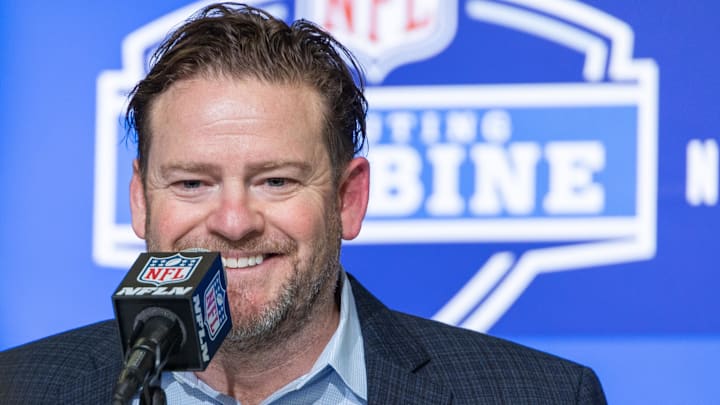The Seattle Seahawks' John Schneider had two exceptional drafts in the past couple of years. Drafting the best player available has been the key.
Drafting the best player isn't always as easy as looking at their college statistics. The college game is vastly different from the NFL; we all know that. Within the collegiate ranks, the competition can vary widely, too. Are Javon Solomon's 16 sacks at Troy the same value as the 8 Bralen Trice posted at Washington? Solomon looks like a great fit for the Hawks, but the Sunbelt Conference didn't provide the opposition that Trice faced in the Pac-12.
That is why the combine matters. The stats are important, the game film even more so. How they got to the quarterback can be even more informative than how often. But it's still subjective information. Speed and strength are objective measurements. Yes, it's still a snapshot taken on one day, but it's a snapshot that can be mitigated on pro days. It's still an objective measurement, and it can be key to drafting the best player.
Seattle Seahawks focus on the best player available
Identifying the best player available isn't always the easiest task. While the Seahawks staff has been studying everything they can in-depth, for the casual fan, some shorthand measures can be helpful. For pass rushers, we want to see those sack numbers, plus total pressures. For offensive linemen, we may look at sacks and pressures allowed. For sheer athleticism, we have the Relative Athletic Score.
Like passer rating or QBR summarizes a quarterback's statistics, RAS gives us one number that combines all the measurables the draftniks talk about. height, weight, 40 times, three-cone drills, it all gets fed into the mathy machine created by Kent Lee Platte at ras.football. RAS combines all of those famous measurables and spits out a single number as a shorthand for how athletic a prospect is. The maximum score is 10.0, meaning the player is ranked at the top in every category. By the way, you can find Mr. Platte on the site formerly known as Twitter here. The comparison tool itself was built by Eric Watkins. Okay, so now that the exposition is done, we can focus on the players' data.
Let's compare Jared Verse to Dallas Turner. Both edge rushers have been ranked in the top 10 prospects at times. Either one could certainly fall to 16 for the Seahawks, should John Schneider elect to stay put there. The Hawks have done their homework on them both, but a quick reference for us commoners is that Relative Athletic Score, or RAS. Verse comes out ahead, 9.60 to 8.86. It boils down to whether you want more speed and explosion - Turner - or more raw strength - Verse.
Dallas Turner vs Jared Verse Relative Athletic Scores. Check our https://t.co/9rZojWIXxw! pic.twitter.com/EKGoSUHqib
— Todd Vandenberg (@TheUnrealTodd) April 24, 2024
Next up, linebackers. Two names that have popped up frequently in mock drafts for the Seahawks are Cedric Gray of North Carolina and Trevin Wallace of Kentucky. Both are viewed as late 3rd or early fourth-round picks, depending on your source. Gray is usually ahead in the rankings. Gray has produced more on the field, while Wallace has often been cited as the better athlete. Wallace easily places ahead of Gray, although I'd like to see his times on the shuttle and three-con drill. Still, Gray has been more consistently productive. Again, RAS is just one of many evaluation tools.
Another RAS comparison from https://t.co/9rZojWIXxw. pic.twitter.com/781YWIKPfr
— Todd Vandenberg (@TheUnrealTodd) April 24, 2024
Let's take a look at the Seahawks draft last year. I'd look at Devon Witherspoon, but of course, he didn't work out at the combine as he was still recuperating from an injury. Let's examine the other first-round pick, Jaxon Smith-Njigba. For our comparison, we'll use the Packers rookie Jayden Reed. JSC was targeted 93 times, while they looked to Reed on 94 attempts. JSN fell behind in top-end speed but took the lead in agility and explosiveness. The biggest factor in Reed's better stats on the field was to depth of target. Green Bay's ADOT was 10.4 yards, Seattle's a meager 6.1.
Another comparison from https://t.co/9rZojWIXxw, this from 2023. pic.twitter.com/jCLvA6ZfRU
— Todd Vandenberg (@TheUnrealTodd) April 24, 2024
As for those lauding Puka Nacua's performance, I'm pretty sure Smith-Njigba's stats would have looked different if they'd targeted him 160 times. Nacua was terrific, absolutely, but nearly 70 more opportunities is a huge advantage in itself. As for Relative Athletic Scores, you get the idea by now, 12s. I encourage you to run your own comparisons - assuming you're mathy.
